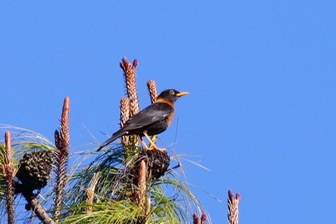Rufous-collared Robin
It is endemic to highlands of Middle America, south of the Isthmus of Tehuantepec, occurring in El Salvador, Guatemala, Honduras, and Chiapas state in Mexico. Its closest relative is the American Robin, and like that species, it is found in varied habitats, from towns to forest. It is, however, restricted to highland areas with at least some trees. It is also known as the Rufous-collared Thrush.

Original source: Natureguy1980
Author: Natureguy1980
Permission: GNU Free Documentation License
The Rufous-collared Robin is classified as Least Concern. Does not qualify for a more at risk category. Widespread and abundant taxa are included in this category.
The Rufous-collared Robin (Turdus rufitorques) is a species of bird in the Turdidae family. It is endemic to highlands of Middle America, south of the Isthmus of Tehuantepec, occurring in El Salvador, Guatemala, Honduras, and Chiapas state in Mexico. Its closest relative is the American Robin, and like that species, it is found in varied habitats, from towns to forest. It is, however, restricted to highland areas with at least some trees. It is also known as the Rufous-collared Thrush. More
Rufous-collared Robins hop in the grass with their high-raised heads turning this way and that, looking for prey down in the grass. In so many ways Rufous-collared Robins are exactly like American Robins, except for conspicuous rufous collars, which basically are the American Robin's "red breast" extended onto and around the neck, as seen at http://www.xelapages.com/gbrc/Rufouscollarthrush.gif. American Robins, Turdus migratorius, don't live this far south. More
young Rufous-collared robin (they hang out in that park). It was still gray underneath on Wednesday, but today the rufous collar and breast are beginning to show and he has lots less spots on his back. The bird is notable in that it doesn't seem to be very shy - it let me get within a couple of meters - and I didn't see if fly, just run. More
Family : Turdidae
Genus : Turdus
Species : rufitorques
Authority : Hartlaub, 1844
